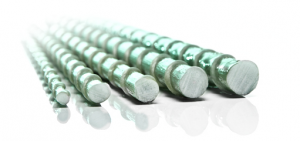GRP Reinforcement Bars
Building elements often must be restored or even replaced because of corrosion damage to the steel reinforcement, leading to a destruction of the concrete structure. This is particularly true for components exposed to de-incing salt. With the deployment of GRP reinforcements, corrosion is an issue of the past. It drastically reduces the number of repairs needed to the construction components. GRP reinforcements are mainly applied to concrete and polymer concrete building parts.

Comparison of Steel- and GRP Reinforcements
| Characteristics | Steel Reinforcement | GRP Reinforcement |
| Material | Steel | GRP |
| Tensile strenght, Mpa | 360-390 | 1200-1300 |
| E-Module, Mpa | 200000 | 60000 |
| Elongation at fracture, % | 25 | 2,2 |
| Lin. expansion- coefficient, 10-6/K |
13-15 | 9-12 |
| Density, kg/dm³ | 7 | 1,9 |
| Length | 6-12 m | 6 m or at request |
| Corrosion- and chemical resistance |
no | yes |
| Thermal conductivity | yes | no |
| Dielectric | no | yes |
| Radiotranslucent | no | yes |
| Insensitive to electromagnetic fields |
no | yes |
| life expectancy | 30 years | 100 years |
Advantages over steel
- resistant to corrosion and acids
- extended service life
- no maintenance required
- lightweight with high tensile strenght
- permeable to magnetic fields and radio frequencies
This post is also available in: Swedish Norwegian Bokmål
